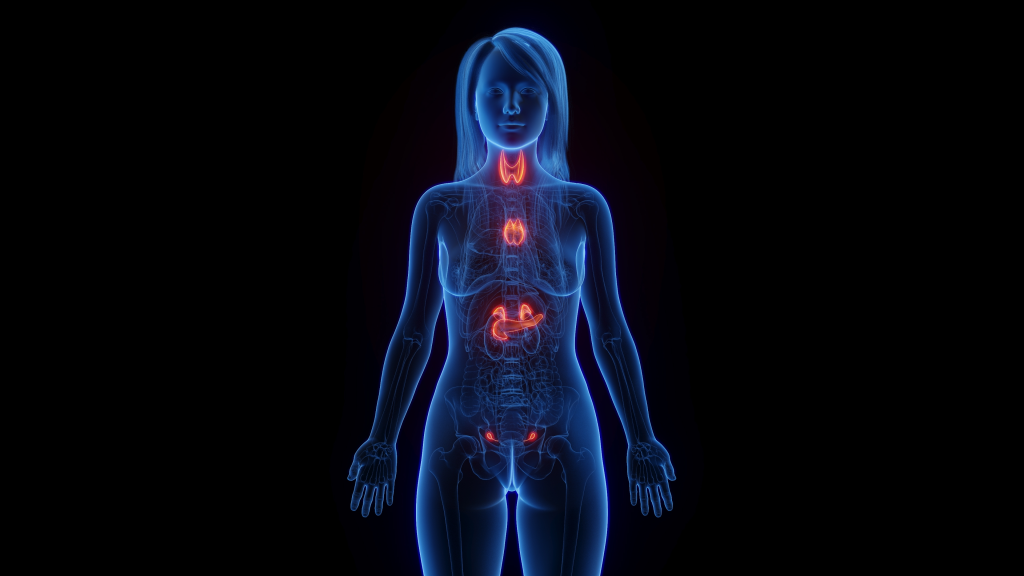At a glance
Hot flashes are sudden waves of intense heat and sweating that occur during menopause, triggered by hormonal fluctuations. They often disrupt sleep and support adrenal health. Therefore, following a nutrient-dense diet, prioritizing cruciferous vegetables, and adopting beneficial lifestyle strategies can help naturally reduce the frequency and severity of hot flashes.
Hot flashes are among the most common menopause symptoms, causing sudden waves of intense heat and sweating that can significantly disrupt a woman’s life and contribute to poor sleep.
Discover what triggers menopausal hot flashes and learn how making dietary and lifestyle changes can support hormone balance and reduce the frequency and intensity of symptoms.
What are menopause and hot flashes?
Menopause refers to the natural stage in a woman’s life when the ovaries stop releasing eggs, which causes menstrual periods to stop and marks the end of fertility.
Menopausal hot flashes are one of the most common menopausal symptoms, often described as a sudden onset of intense body heat that most often affects the upper body.
Data published by the North American Menopause Society (NAMS) suggests that around 80 percent of women experience hot flashes during menopausal transition.
Changes in hormone levels during menopause can affect how the brain controls body temperature, making hot flashes a disruptive experience that can interfere with daily activities, sleep, and overall well-being.
Watch the video below to discover simple and effective natural remedies to manage hot flashes.
Menopause vs. perimenopause
A woman’s transition from her reproductive years to a time when she is no longer fertile occurs in stages, which are primarily governed by hormonal changes.
Most women start their reproductive life period with around 400 to 500 eggs, which are gradually released during the monthly menstrual cycle.
As the number of eggs decreases over time, hormone levels fluctuate, leading to the changes and symptoms commonly experienced during perimenopause, menopause, and post-menopause.
The three stages of menopausal transition include:
- Perimenopause is the transition phase before menopause. Hormone levels fluctuate, menstrual cycles become irregular, and symptoms such as hot flashes, sleep changes, and mood swings may develop.
- Menopause occurs after 12 consecutive months without a menstrual period, marking the end of fertility. Severity of hot flashes and other symptoms often peaks during this time.
- Post-menopause is the stage after menopause, when periods have stopped completely, but menopausal symptoms may persist.
In addition, some women experience surgical menopause. This refers to the onset of menopausal symptoms and hormonal changes caused by the surgical removal of the ovaries, often performed due to ovarian or endometrial cancer or as part of a total hysterectomy.

Signs of menopause-related hot flashes
Hot flashes typically involve a sudden, severe sensation of heat, accompanied by flushed skin. The intense warmth usually begins in the upper body and most commonly affects the face, neck, and chest.
Severe hot flashes can also trigger profuse sweating, a rapid heartbeat, and feelings of anxiety or discomfort, often disrupting sleep and daily activities.
Research published in StatPearls reports, “Hot flashes can persist for six months to several years, usually decreasing in frequency and intensity over time after the final menstrual period.”
In addition to hot flashes, other menopause symptoms include:
- Sleep disturbances
- Mood changes
- Brain fog
- Vaginal dryness
- Decreased libido
- Skin changes
- Hair loss
- Weight gain
- Fatigue

Causes and risk factors
Hot flashes happen as a result of hormone-related disruptions in the body’s internal temperature regulation.
Research published in the Journal of Mid-Life Health reports that the hypothalamus, which is responsible for maintaining core body temperature, becomes more sensitive when estrogen levels decline during menopause.
Even small fluctuations in body temperature can influence blood flow and trigger the widening of blood vessels, resulting in sudden sensations of internal heat, flushing, and sweating.
Furthermore, menopausal changes can affect the adrenal glands, which play a crucial role in maintaining hormone balance.
“During menopause, the body shifts estrogen production to the adrenal glands,” explains Dr. Berg. “However, weak adrenal glands, often linked to a stressful lifestyle, may not adequately compensate for the drop in estrogen.”
This can worsen hot flashes and may explain why women who experience chronic stress, as well as those with thyroid disorders, diabetes, or autoimmune diseases, are more likely to develop more frequent and severe menopausal symptoms.
In addition, certain dietary and environmental factors can trigger hot flashes, including hot weather, spicy foods, alcohol, excessive caffeine intake, and smoking.

What to do if you experience hot flashes
Although hormone therapy is often used as the primary treatment of hot flashes, this may not be suitable for everyone, especially breast cancer survivors and those at higher risk of estrogen-sensitive health issues.
Making beneficial dietary and lifestyle changes can play a powerful role in easing discomfort and improving daily life.
Here are five ways you can help manage bothersome hot flashes.
1. Support the adrenal glands
Because poor adrenal health can worsen menopausal symptoms, strengthening adrenal function is key to reduce hot flashes.
These are crucial steps for supporting healthy adrenal glands:
- Practice stress-reduction techniques
- Schedule sufficient downtime
- Prioritize quality sleep
- Regularly engage in physical activity, but avoid overtraining
- Avoid processed foods, added sugars, and refined carbohydrates
- Reduce stimulants such as alcohol, caffeine, and tobacco

2. Follow Healthy Keto®
A study published in Current Obesity Reports suggests that a low-carb ketogenic diet has shown potential therapeutic benefits for reducing menopausal symptoms.
Limiting carbohydrate intake triggers various profound metabolic changes that support hormonal balance and improve adrenal function, which are critical for lessening the severity of hot flashes.
Healthy Keto® is an advanced low-carb meal plan that supports nutrient balance, stabilizes energy, and provides essential vitamins and minerals the body needs during menopausal transition.
3. Prioritize cruciferous vegetables
Consuming a variety of cruciferous vegetables can help support healthy estrogen balance during menopause.
These vegetables are rich in natural compounds, such as diindolylmethane (DIM) and sulforaphane (which support effective estrogen metabolism), linked to a lower risk of severe menopausal symptoms.
Some of the best cruciferous vegetables include:
- Broccoli
- Broccoli sprouts
- Brussels sprouts
- Cabbage
- Cauliflower
- Kale
- Mustard greens

4. Practice cold exposure
Research published in Post Reproductive Health found that women who practiced cool exposure through regular cold water swimming reported reduced perimenopausal symptoms, including hot flashes and mood swings.
Regular cold exposure can improve body heat regulation, which may help alleviate hot flashes. In addition to cold water therapy, using a fan, lowering the air conditioning thermostat, or spending time outside on chilly days can help provide relief.
5. Opt for organic produce
Choosing organic produce whenever possible may help minimize hot flashes by reducing exposure to hormone-disrupting chemicals and supporting overall detoxification processes.
Conventional fruits and vegetables are often treated with pesticides, which can act as endocrine disruptors, potentially interfering with estrogen metabolism and hormone balance.

When to see a doctor
Although hot flashes occur frequently in many menopausal women, it’s important to speak with a doctor if symptoms are severe, frequent, or disruptive.
It’s also recommended to seek medical care if you develop sudden mood changes, sleep disturbances, or unexplained weight changes. While these symptoms are often related to menopause, they can also signal underlying health issues that warrant evaluation by a healthcare professional.
In addition, menopausal women with an increased risk of breast cancer, heart disease, or blood clots should discuss available treatment options carefully before starting hormone replacement therapy or estrogen therapy.
Doctors can recommend safe strategies and prescribe medications to help treat hot flashes and improve quality of life while minimizing potential health risks of hormone therapy.
Key takeaways
- Hot flashes are a common menopausal symptom triggered by hormone-related changes that affect the brain’s temperature regulation.
- Supporting adrenal health through stress reduction, prioritizing quality sleep, and limiting alcohol, caffeine, and other stimulants can help reduce hot flashes.
- A low-carb, Healthy Keto diet rich in nutrient-dense foods can further support hormonal balance during menopause.
- Regularly incorporating cruciferous vegetables can aid estrogen metabolism and may help reduce the severity and frequency of hot flashes.
- Lifestyle strategies, such as cold exposure and choosing organic produce, can also support hormone regulation and overall comfort during the menopausal transition.
FAQ
1. What are the first signs of hot flashes?
The first signs of hot flashes are usually a sudden feeling of intense warmth in the face, neck, or chest, often accompanied by flushing and sweating. Disrupted sleep is also a common early sign of menopausal-related changes in temperature regulation.
2. How long do hot flashes usually last?
Hot flashes typically last between two and five minutes. However, more severe hot flashes can last up to ten minutes.
3. What triggers hot flashes?
Hot flashes start during perimenopause due to declining estrogen levels. They can be triggered or worsened by factors such as hot weather, spicy foods, stress, alcohol, caffeine, and sudden changes in body temperature.
4. What can I do to relieve hot flashes naturally?
Supporting adrenal health through effective stress reduction, adequate sleep, and limiting alcohol, caffeine, and tobacco is vital for managing hot flashes.
In addition, following a low-carb diet, incorporating cruciferous vegetables, and choosing organic produce can further support estrogen metabolism and overall hormone regulation.
5. Do all women experience hot flashes during menopause?
Most women experience hot flashes, with around 80 percent reporting them at some point during menopause transition.
6. What’s the difference between hot flashes and night sweats?
Hot flashes are sudden feelings of intense heat that can occur at any time during the day. When these hot flashes occur during sleep, they’re called night sweats and are a common cause of poor sleep during menopause.
7. Are hot flashes ever a sign of something more serious?
Hot flashes are generally a normal part of menopause and not a serious medical concern. However, sudden changes in body temperature control or severe, persistent hot flashes may indicate an underlying health issue that should be evaluated by a healthcare professional.
Sources
- https://menopause.org/patient-education/menopause-topics/hot-flashes
- https://www.ncbi.nlm.nih.gov/books/NBK539827/
- https://pmc.ncbi.nlm.nih.gov/articles/PMC6459071/
- https://pmc.ncbi.nlm.nih.gov/articles/PMC10482777/
- https://journals.sagepub.com/doi/10.1177/20533691241227100


















